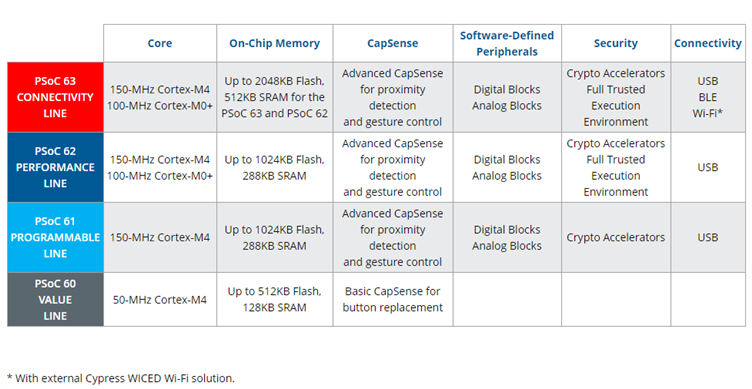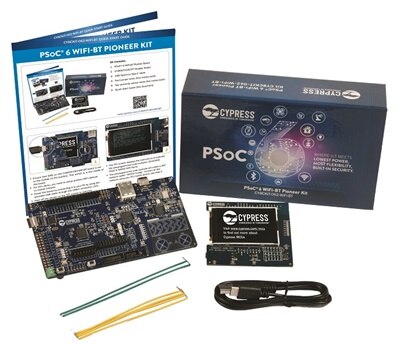The roll out of new products and kits to help you develop IoT-based products is a trend that is just not stopping! Last year we roadtested Cypress's PSoC 6 BLE Pioneer Kit. And this year they are releasing the PSoC
6 WiFi-BT Pioneer Kit to help you develop PSoC 6 MCU + WiFi applications. With the growth of Wi-Fi-enabled devices in and out of the home, new dev kits in this mix shouldn't be surprising. So, let's look at this kit and see what you can build with it.
Let's start with the PSoc 62 which is featured in this dev board.
A few facts: The PSoC 62 MCU: a single- or dual-core MCU, with an Arm Cortex
-M4 and Arm
Cortex
-M0+, 1MB of Flash, 288KB of SRAM, 104 GPIO, 7 programmable analog blocks, 56 programmable digital blocks, Full-Speed USB, a serial memory interface, a PDM-PCM digital microphone interface, and industry-leading capacitive-sensing with CapSense
.

The CPU subsystem in the PSoC 62 consists of two ARM Cortex cores and their associated busses and memories: M4 with Floating-point unit and Memory Protection Units (FPU and MPU) and an M0+ with an MPU. The Cortex M4 and M0+ have 8-KB Instruction Caches (I-Cache) with 4-way set associativity. This subsystem also includes independent DMA controllers with 32 channels each, a Cryptographic accelerator block, 1 MB of on-chip Flash, 288 KB of SRAM, and 128 KB of ROM.
The Cortex M0+ provides a secure, un-interruptible Boot function. This guarantees that post-Boot, system integrity is checked and privileges enforced. Shared resources can be accessed through the normal ARM multi-layer bus arbitration and exclusive accesses are supported by an Inter-Processor Communication (IPC) scheme, which implements hardware semaphores and protection. Active power consumption for the Cortex M4 is 26 µA/MHz and 17 µA/MHz for the Cortex M0+, both at 3V chip supply voltage with the internal buck enabled and at 0.9V internal supply.
Now let's look at some of the features on the PSoC 6 WiFi-BT Pioneer Kit.
The PSoC 6 WiFi-BT Pioneer board offers compatibility with Arduino shields. The board features a PSoC 6 MCU, a 512-Mb NOR flash, an onboard programmer/debugger (KitProg2), a 2.4-GHz WLAN and Bluetooth functionality module (CYW4343W), a USB Type-C power delivery system (EZPD
CCG3), a five-segment CapSense slider, two CapSense buttons, one CapSense proximity sensing header, an RGB LED, two user LEDs, USB host and device features, and one push button. The board supports operating voltages from 1.8 V to 3.3 V for the PSoC 6 MCU.

The CY8CKIT-062-WiFi-BT package includes a CY8CKIT-028-TFT Display Shield that contains a 2.4-inch TFT display, a motion sensor, ambient light sensor, a 32-bit audio codec, and a PDM microphone. The PSoC 6 WiFi-BT Pioneer Kit features the Murata LBEE5KL1DX module, that provides IEEE 802.11a/b/g/n WLAN + Bluetooth, best-in-class power consumption, and enables small form factors for IoT devices.
The PSoC 6 WiFi-BT Pioneer Kit base board includes a Cypress EZ-PD CCG3 power delivery system. It comes preprogrammed and can deliver power from a Type-C port to an on-board header while simultaneously charging a 3.7-V lithium-ion polymer battery. In addition, the power delivery system can provide power to a Type-C peripheral such as a cell phone with power derived from an external source.
To develop a PSoC 6 MCU + WiFi application, WICED Studio 6.1 or later must be used. WICED Studio is Cypress' integrated development environment (IDE) for developing WiFi applications. If you are not adding WiFi to your design then you can develop and debug PSoC 6 MCU project using PSoC Creator
. PSoC Creator supports exporting your designs to other third-party firmware development tools.
What can you build with the PSoC 6 WiFi-BT Pioneer Kit?
Depends...on you. But it's made for IoT applications and wearable devices, which makes sense since this PSoC is ultra low power. But one needs to remembers that this kit has a high-performance PSoC 6 MCU. More facts: It has a programmable embedded system-on-chip, integrating a 150-MHz Arm Cortex
-M4 as the primary application processor, a 100-MHz Arm Cortex-M0+ that supports lowpower operations, up to 1MB Flash and 288KB SRAM, CapSense
touch-sensing, and programmable analog and digital peripherals that allow higher flexibility and in-field tuning of the design.
I think the question isn't what you can build with this kit, but what can you build that really needs a high performance MCU? You tell me.
So think about it and when I launch the roadtest in September, write me a high-performance roadtest application that tells it all.
Additional Information

